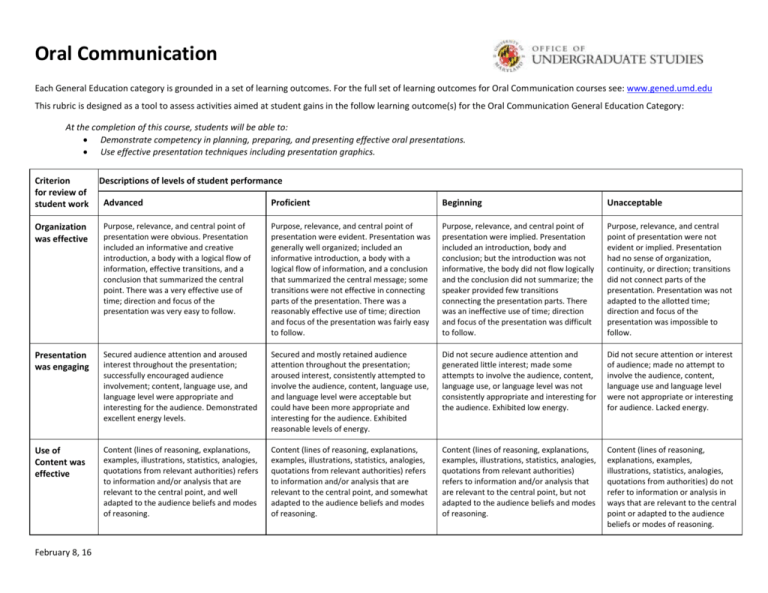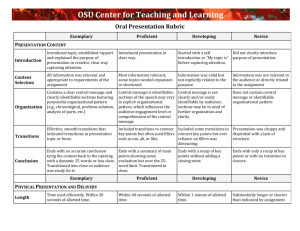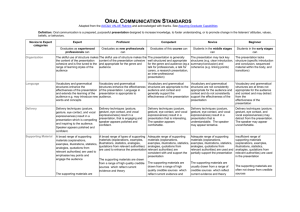Oral Communication - General Education
advertisement

Oral Communication Each General Education category is grounded in a set of learning outcomes. For the full set of learning outcomes for Oral Communication courses see: www.gened.umd.edu This rubric is designed as a tool to assess activities aimed at student gains in the follow learning outcome(s) for the Oral Communication General Education Category: At the completion of this course, students will be able to: Demonstrate competency in planning, preparing, and presenting effective oral presentations. Use effective presentation techniques including presentation graphics. Criterion for review of student work Descriptions of levels of student performance Advanced Proficient Beginning Unacceptable Organization was effective Purpose, relevance, and central point of presentation were obvious. Presentation included an informative and creative introduction, a body with a logical flow of information, effective transitions, and a conclusion that summarized the central point. There was a very effective use of time; direction and focus of the presentation was very easy to follow. Purpose, relevance, and central point of presentation were evident. Presentation was generally well organized; included an informative introduction, a body with a logical flow of information, and a conclusion that summarized the central message; some transitions were not effective in connecting parts of the presentation. There was a reasonably effective use of time; direction and focus of the presentation was fairly easy to follow. Purpose, relevance, and central point of presentation were implied. Presentation included an introduction, body and conclusion; but the introduction was not informative, the body did not flow logically and the conclusion did not summarize; the speaker provided few transitions connecting the presentation parts. There was an ineffective use of time; direction and focus of the presentation was difficult to follow. Purpose, relevance, and central point of presentation were not evident or implied. Presentation had no sense of organization, continuity, or direction; transitions did not connect parts of the presentation. Presentation was not adapted to the allotted time; direction and focus of the presentation was impossible to follow. Presentation was engaging Secured audience attention and aroused interest throughout the presentation; successfully encouraged audience involvement; content, language use, and language level were appropriate and interesting for the audience. Demonstrated excellent energy levels. Secured and mostly retained audience attention throughout the presentation; aroused interest, consistently attempted to involve the audience, content, language use, and language level were acceptable but could have been more appropriate and interesting for the audience. Exhibited reasonable levels of energy. Did not secure audience attention and generated little interest; made some attempts to involve the audience, content, language use, or language level was not consistently appropriate and interesting for the audience. Exhibited low energy. Did not secure attention or interest of audience; made no attempt to involve the audience, content, language use and language level were not appropriate or interesting for audience. Lacked energy. Use of Content was effective Content (lines of reasoning, explanations, examples, illustrations, statistics, analogies, quotations from relevant authorities) refers to information and/or analysis that are relevant to the central point, and well adapted to the audience beliefs and modes of reasoning. Content (lines of reasoning, explanations, examples, illustrations, statistics, analogies, quotations from relevant authorities) refers to information and/or analysis that are relevant to the central point, and somewhat adapted to the audience beliefs and modes of reasoning. Content (lines of reasoning, explanations, examples, illustrations, statistics, analogies, quotations from relevant authorities) refers to information and/or analysis that are relevant to the central point, but not adapted to the audience beliefs and modes of reasoning. Content (lines of reasoning, explanations, examples, illustrations, statistics, analogies, quotations from authorities) do not refer to information or analysis in ways that are relevant to the central point or adapted to the audience beliefs or modes of reasoning. February 8, 16 Vocal Delivery was effective Spoke articulately and in conversational tone for the duration of the presentation; voice levels, rate, pitch & tone effectively varied. Correct pronunciation; excellent flow of sentences; used few vocal fillers. Voice levels, rate, pitch and tone were acceptable; pronunciation was mostly correct; articulation was clear but not completely polished; some vocal fillers. Voice levels, rate, pitch and tone lacked variety; some words were mispronounced; filler words were used to the point of distraction. Spoke unclearly throughout the presentation; mispronounced words; had little variety of voice qualities and had long pauses or many filler words that distracted from the vocal delivery. Visual Delivery was effective Good posture; appeared confident; excellent eye contact with entire audience; no distracting behavior; used speaking notes and gestures effectively; appearance was appropriate for the situation Posture was reasonably good; eye contact was acceptable; returned to notes regularly; some fidgeting and few distracting behaviors; appearance fit the situation and gestures were sometimes effective. Slouched, fidgeted, & distracted audience; minimal eye contact; primarily read from notes; did not connect with the audience; appearance did not fit the situation and gestures were ineffective. Made very little or no eye contact with the audience; consistently read from notes; poor posture and distracting behavior; no connection with the audience; appearance or gestures were inappropriate or offensive to the audience. Credibility was effectively established Speaker was well prepared and extremely knowledgeable on the topic; speaker was enthusiastic, respectful, trustworthy, and projected exceptional confidence; speaker used a variety of appropriate sources; all citations were attributed accurately and correctly; all supporting material was relevant and accurate. Speaker was prepared and knowledgeable on the topic; speaker was respectful, trustworthy, and projected confidence; speaker used appropriate sources; citations were attributed accurately and correctly; supporting material was relevant and accurate. Speaker demonstrated some preparation and knowledge on the topic; speaker was respectful and trustworthy but lacked confidence; speaker used mostly appropriate sources; citations were attributed accurately; supporting material was somewhat relevant and generally accurate. Speaker was not prepared, and was not knowledgeable on the topic speaker was not respectful or trustworthy; sources were inappropriate, inaccurately attributed or missing; supporting material was irrelevant, inaccurate, or nonexistent. Use of AudioVisual Technology was effective Overall, audio-visuals were integrated into and enhanced the presentation; all graphics were attractive, well-designed, easy to read, appropriate to the audience and added to the audience’s understanding; presenter was facile with & operated all audio-visual technology expertly. Audio-visuals supported the presentation; graphics were reasonably well-designed, attractive & appropriate; presenter demonstrated a familiarity with the audiovisual aids and equipment. Audio-visuals were used but distracted from the presentation; graphics were sometimes poorly constructed, unattractive and/or difficult to read; some audio visuals were not appropriate for the audience; presenter seemed unsure of how to operate the audio-visual aids. Audio-visual technology was not used, was inappropriate, did not work, or presenter was unable to operate the equipment. The Oral Communication Rubric was developed by the Oral Communication Faculty Board, supported by the Office of Undergraduate Studies and the Office of Institutional Research, Planning, and Assessment with the Oral Communication instructors upon review of the AAC&U VALUE rubrics and according to standards determined by the Oral Communication Faculty Board for student performance in the General Education Oral Communication courses. The rubric defines the standards for student performance in Oral Communication courses at the University of Maryland. February 8, 16






